Oshkosh L-ATV
| Oshkosh L-ATV | |
|---|---|
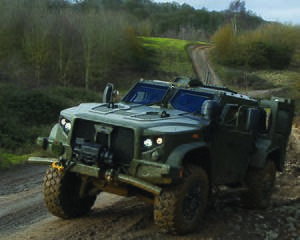 Oshkosh L-ATV in British Army green during a UK demonstration. | |
| Type | light multi-role vehicle/light tactical vehicle |
| Place of origin | United States |
| Service history | |
| In service | FY 2019 (planned)[1] |
| Used by |
United States Army United States Marine Corps |
| Production history | |
| Designer | Oshkosh |
| Designed | 2011[2] |
| Unit cost |
$250,000 (base vehicle)[3] $400,000-$560,000 (including R&D, radios, weapons, and armor)[4][3] |
| No. built |
49,099 (Army) 5,500 (Marines)[5] (these are current requirements; details in main text) |
| Variants |
All JLTV M1278 Heavy Guns Carrier[2] M1279 Utility [2] M1280 General Purpose [2] M1281 Close Combat Weapons Carrier [2] JLTV-RV (JLTV - Reconnaissance Vehicle) Selected |
| Specifications | |
| Weight | Curb weight: 14,000 lb (6,400 kg) |
| Length | 20.5 ft (6.2 m) |
| Width | 8.2 ft (2.5 m) |
| Height | 8.5 ft (2.6 m) |
| Crew | 2 |
|
| |
| Armor | classified (A-kit/B-kit configuration) |
Main armament | a variety of light and medium caliber weapons, AGLs, or ATGMs can be fitted |
Secondary armament | smoke grenade launchers |
| Engine |
Gale Banks Engineering 866T, 6.6-liter diesel (based on GM Duramax architecture)[6] est. 300 hp (224 kW) |
| Transmission | Allison 6-speed automatic; Oshkosh transfer case |
| Suspension | Oshkosh TAK-4i independent suspension |
Operational range | 300 miles (480 km) |
| Speed |
Forward Road: 70 mph (110 km/h) Off road: varies Reverse: 8 mph (13 km/h) |
Steering system | Power-assisted, front wheels |
The Oshkosh L-ATV (Light Combat Tactical All-Terrain Vehicle) is a light utility/combat multi-role vehicle that won the US military's Army-led Joint Light Tactical Vehicle (JLTV) program. In the very early stages of the program it was suggested that JLTV would replace the AM General High Mobility Multi-purpose Wheeled Vehicle (HMMWV) on a one-for-one basis. It is now suggested that the JLTV will part-replace the HMMWV, not replacing it on a like-for-like basis.[7]
Oshkosh's L-ATV will deliver a level of protection similar to that of current, but far heavier and less maneuverable, Mine Resistant Ambush Protected (MRAP) class designs, these having far more protection from blast than even the latest up-armored HMMWVs.[8]
On 25 August 2015, the L-ATV was selected as the winner of the JLTV program.[4] The first JLTV delivery order was placed in March 2016 with the U.S. Army ordering 657 trucks.[9] Overall JLTV requirements are 5,500 vehicles for the Marine Corps entering service in FY 2020 with all to be delivered in FY 2022, and 49,099 for the Army entering service in late 2019 with deliveries occurring through 2040. The Army received its first seven JLTVs for test at the end of September 2016, Colonel Shane Fullmer, JLTV project manager stated at an AUSA 2016 media briefing.[10]
History
Background
The idea for the Joint Light Tactical Vehicle (JLTV) first emerged in 2006 from threats experienced during the Iraq War. The primary tactical wheeled vehicle used by the U.S. military at the start of the war was the Humvee. However, it was unarmored and built for payload mobility, so the type incurred heavy losses when improvised explosive devices (IEDs) began being employed by insurgents. The initial response was to add armor to existing Humvees, and primarily on the sides. This improved side protection against direct fire and associated threats, but since the chassis was not designed to handle any further additional weight, there was little room for underbody protection. The additional weight impacted on overall reliability and compromised off-road mobility.
To combat increasing numbers of IED attacks, the U.S. spent around $50 billion rapidly procuring some 29,000 Mine Resistant Ambush Protected (MRAP) vehicles, including the Oshkosh M-ATV for use in Iraq and Afghanistan. While MRAPs offered superior protection from IEDs, especially underbody blasts, they were significantly larger and heavier and had poor off-road mobility. The military incorporated MRAPs in response to operational needs, but never intended them to become a permanent part of their tactical wheeled vehicle fleets. At the conclusion of operations, many thousands were either scrapped, adapted for other roles, or offered for sale/transfer to allies. Ultimately U.S. armed forces would retain over 11,100 MRAPS, just over 6,350 of these Oshkosh M-ATVs. The bulk of retained MRAPS will ultimately be mothballed in prepositioned stocks around the world.[11]
Since up-armoring Humvees and buying MRAPs addressed specific issues but created gaps in vehicle capabilities, the JLTV program was started to incorporate lessons learned and balance payload, mobility, and protection into a new vehicle. Its purpose was to restore the mobility commanders had with the original Humvee, while having the side and underbody protection of a basic MRAP. It would be around two-thirds the weight of an MRAP, possible to be carried under a CH-47 Chinook and CH-53E Super Stallion and by amphibious vessels, things impossible for an MRAP. It would also be 70 percent faster off-road, adding to survivability by enabling it to egress a combat situation faster. Compared to the Humvee, the JLTV was to have the mobility of early unarmored versions with greater protection than up-armored versions, along with greater reliability, payload capacity, and ease of repair. The JLTV is the first vehicle purpose-built for network connectivity into the Warfighter Information Network-Tactical.[4][12][13][14][15]
Unveiling and testing
Oshkosh Defense first displayed the L-ATV at Association of the United States Army (AUSA) in Washington, D.C. on 10 October to 12 October 2011. This, the first 'public appearance' for the design, was not an open appearance and came in the form of closed combined briefings/viewings to invited attendees only. Oshkosh briefed Jane's Independent Defense Review[16] that the L-ATV has developmental origins that trace back to 2007 and Oshkosh/Northrop-Grumman's failed JLTV proposal, with some sub-systems having a lineage that trace back to 2005. At the time, L-ATV was the lightest tactical vehicle designed by Oshkosh, being some 50% lighter than anything previously produced by the company.
At AUSA 2011, Oshkosh suggested that following then recent program developments, L-ATV would be offered to meet the recently revitalized JLTV's EMD (Engineering & Manufacturing Development) phase.[17] On 26 January 2012, the RFP for JLTV's EMD Phase was released.[18] On 23 August 2012, the Army and Marine Corps selected the Oshkosh Defense L-ATV, as well as the Lockheed Martin JLTV entry and AM General BRV-O, as the winners of the Engineering and Manufacturing Development (EMD) phase of the JLTV competition. They were awarded a contract to build 22 prototype vehicles in 27 months to be judged by the services.[19]
On 6 February 2013, Oshkosh unveiled the Utility Variant of its JLTV offer, fulfilling JLTV's requirement for a two-seat cargo vehicle. The vehicle's performance was demonstrated at the 2013 NATC Technology Rodeo at the Nevada Automotive Test Center (NATC). The Utility Variant is designed to provide mobility for loads such as containers, pallets, and break bulk cargo. It can also be outfitted as a shelter carrier to carry standard shelters for communications systems, on-board electronics, and other functions. Payload capacity is in excess of 5,100 pounds. Both Oshkosh L-ATV variants leverage a common crew protection system, automotive systems, and the patented Oshkosh TAK-4i™ intelligent independent suspension system.[20]
In June 2013, L-ATV prototypes participated in an event hosted by the U.S. JLTV Joint Program Office in Quantico, VA. The vehicles successfully completed the severe off-road track (SORT) without failure. The SORT demonstrated the L-ATV's ability to maneuver steep inclines, turn sharply, and operate in rugged terrain.[21] On 8 August 2013, Oshkosh delivered its first L-ATV JLTV prototype to the Army for government testing following a successful vehicle inspection by the Defense Contract Management Agency (DCMA). The four-door variant (which has two base platforms – Close Combat Weapons Carrier (CCWC) and the General Purpose (GP))[22] and two-door Utility Variant were provided for evaluations.[23]
On 27 August 2013, the Army and Marine Corps announced that full-scale testing of JLTV prototypes would begin the following week, with all three vendors having had 66 vehicles delivered. Each company delivered 22 vehicles and six trailers to Aberdeen Proving Ground, Maryland, and Yuma Proving Ground, Arizona. Previous testing had already put the vehicles through more than 400 ballistic and blast tests on armor testing samples, underbody blast testing, and more than 1,000 miles in shakedown testing. Soldiers from the Army Test and Evaluation Command and personnel from the Defense Department's Office of Test and Evaluation would begin to put the vehicles through realistic and rigorous field testing during 14 months of government performance testing. Testing was scheduled for completion by FY 2015, with a production contract to be awarded to a single vendor for almost 55,000 vehicles (49,099 Army; 5,500 Marines). The average unit manufacturing cost in A-kit (fitted for but not with armor) configuration was not to exceed $250,000. The Army set an Initial Operating Capability (IOC) of May 2018 and planned to complete its fielding by FY2040. The Marines had an IOC of December 2017, and planned to complete its fielding by FY2022. On 3 September 2013, full-pace, full-scope JLTV testing began at Aberdeen Proving Ground, Yuma, and Redstone Arsenal, Alabama. One vendor was to be selected by July 2015, and produce 2,000 vehicles for three years of additional testing to fine-tune the assembly line and full-up the system.[24][25][26][27][28]
In July 2014, the L-ATV completed Net-Ready testing as part of the JLTV program, involving transferring data from onboard systems to external networks.[29] On 17 July 2014, Oshkosh announced the L-ATV had completed 200,000 miles and all requirements for Reliability, Availability, Maintainability (RAM) testing.[30] On 19 November 2014, Oshkosh announced the L-ATV had completed Limited User Testing (LUT) with the U.S. Army and Marine Corps for the JLTV EMD contract. The LUT focused on JLTV system capabilities, functions, operations, and interfaces in a range of simulated tactical environments covering operator and crew-level preventive maintenance for the entire system, ensuring they could operate proficiently and safely. The Army held theirs the previous September and October, where three tests were held as 96-hour cycles to simulate operational missions, one of which incorporated a live fire demonstration. The Marines completed two test cycles in October and November with one live fire demonstration.[31] The Army released the final JLTV RFP on 12 December 2014.[32] On 10 February 2015 Oshkosh Defense issued a press release announcing the company had submitted its proposal (the L-ATV) in response to the JLTV Low Rate Initial Production (LRIP) and Full Rate Production (FRP) RFP.[33]
On 31 March 2015, Oshkosh announced it would show its JLTV offering, the L-ATV, at the AUSA 2015 Global Force Symposium and Exposition in Huntsville, Alabama. The company also announced it would show its Virtual Task Trainer (VTT) for the L-ATV at the conference. The VTT is an interactive training module that provides interactive 3D training for soldiers in a safe and lifelike virtual environment. Speaking of the VTT, Mike Ivy, vice president of global integrated product support for Oshkosh Defense said: "The addition of Oshkosh's virtual training to our multi-faceted curriculum reduces the cost of operator training by improving training effectiveness and efficiency." He added: "We deployed the VTT to train operators during early JLTV testing with great results. Soldiers were really engaged, and our training was not only better, but it took less time than it would have without the VTT. This represents a significant cost savings opportunity for the government."[34]
Selection and JLTV production
On 25 August 2015, the Army selected the Oshkosh L-ATV as the winner of the JLTV program. The company was awarded a $6.75 billion low rate initial base contract with eight option years to procure the first 16,901 vehicles for both the Army and Marines. Oshkosh CEO, Charles Szews, said the production contract award would involve more than 300 suppliers in 31 states across the country. The Army initially refused to detail why the L-ATV was chosen over its competitors, likely owing to anticipations of protests from the losing bidders.[4]
On 8 September it was disclosed that Lockheed Martin would protest the award to Oshkosh; on the same day it was also disclosed that AM General had decided not to file a protest. Any work that would be performed under the contract stopped during the review period.[35] On December 15 the Government Accountability Office (GAO) dismissed Lockheed Martin's protest because the company on December 11 decided to file a “Notice of Post-Award Bid Protest” with the U.S. Court of Federal Claims; according to a source with knowledge of the procedures, it is uncommon for a company to file with the court close to a GAO protest decision.[36] Immediately after the GAO dismissed the protest, the Army instructed Oshkosh to resume work on the JLTV order.[37] Lockheed filed their preliminary injunction on 17 December, claiming that new Army-supplied information related to the contract emerged toward the end of the GAO’s protest process that was not considered before their ruling and no deadline extension was granted.[38] On 17 February 2016, Lockheed withdrew their protest of the JLTV contract award decision in the Court of Federal Claims,[39] potentially as a result of the release of JLTV testing data showing that the L-ATV lasted nearly six times longer between significant breakdown than Lockheed's vehicle.[40][41]
The first JLTV order was announced on 23 March 2016 with the U.S. Army ordering 657 JLTVs. The $243 million order includes vehicles for the Army and Marines. For clarity, as part of the original JLTV LRIP/FRP Base Award in August 2015, an initial 201 JLTVs for the test and evaluation phase were ordered. The 657-vehicle order is an exercised option from the program's eight option years.[42]
In June 2017 the first US soldiers to receive JLTVs was revealed. According to the Army its first unit to receive JLTVs will be an infantry brigade combat team in the 10th Mountain Division at Fort Drum and according to the Marines, a yet-to-be-identified infantry battalion within II Marine Expeditionary Force at Camp Lejeune, North Carolina, will receive its JLTVs in July 2019.[43] Also in June 2017 the Marines revealed they wished to adjust their acquisition objective for JLTV by 65% to up to 9,091 vehicles. For clarity, overall JLTV requirements still remain 5,500 for the USMC and 49,099 for the army.[44]
In August 2017 further details the U.S. Air Force's FY18 budget request for JLTVs were published. Beginning in FY 2019, the first of 140 units could be fielded, these including 46 Utility variants, 48 General Purpose variants, and 46 Heavy Gun Carrier variants, these to be operated by Air Force security forces, explosive ordnance disposal teams, pararescue and personnel recovery units, tactical air control party teams, and special tactics forces. The Air Force wishes to eventually replace its entire inventory of 3,270 Humvees with JLTVs.[45]
On 1 Sept 2017 Oshkosh announced the sixth JLTV order, this including 611 vehicles and 1,789 installed and packaged kits. The order is valued at more than $177 million.[46] Oshkosh also confirmed the JLTV remains on-schedule and on-budget.[47]
At AUSA 2017 JLTV's were displayed in three new configurations. Oshkosh displayed a General Purpose variant fitted with a Boeing Compact Laser Weapon System (CLWS), a Kongsberg Protector LW 30 Remote Weapon System (RWS) with a M230LF cannon, and a communications suite that includes a Thales VRC-111 and Thales VRC-121 VIPER. The company also displayed a Utility variant equipped with the Boeing Maneuver Short Range Air Defense (SHORAD) Launcher including a M3P .50 cal machine gun, M299 launcher with four Longbow Hellfire missiles, sensor suite, and a communications suite including a Thales VRC-111. Rafael displayed a General Purpose vehicle fitted with the company's Samson RWS Dual Stabilized Remote Weapon Systems (RWS) with M230 LF, and the Trophy Light Active Protection System (APS).[48][49]
On 21 December 2017, Oshkosh announced the seventh JLTV order, this valued at $100.1 million and including 258 vehicles and associated installed and packaged kits. At this time it was also announced that to date over 1,000 JLTVs had been delivered.[50] On 5 February 2018, Oshkosh announced the eighth JLTV order, this valued at $106 million and including 416 vehicles and associated installed and packaged kits.[51] On 29 June 2018, Oshkosh announced the ninth and latest JLTV order, this valued at $484 million and including 1,574 vehicles and associated installed and packaged kits.[52] This ninth order brings the total of JLTVs ordered to date to 5,004. Full-rate production should begin in November or December 2019 ahead of fielding, and initial operating capability is expected for early to mid-2020. For clarity, overall JLTV requirements still remain 5,500 for the USMC and 49,099 for the army.
Foreign interest
In June 2016, the British Ministry of Defence (MOD) confirmed it was discussing a potential Foreign Military Sales (FMS) deal with the U.S. military for the L-ATV. The vehicle is being considered for the British Army's Multi Role Vehicle-Protected (MRV-P) Package 1 requirement for troop carrying and other light duties, part of a program to equip the Army with several types of wheeled armored vehicles to support rapid deployment and regular forces. It is not typical for the U.S. government to do FMS sales until there is a full production rate decision on the equipment, but that requirement could be waived given the overall maturity of the JLTV platform.[53] In July 2017, the Defense Department announced the UK planned to spend up to US$1.04 billion to supply the British military with a maximum of 2,747 of the vehicles.[54]
The Lithuanian Ministry of Defence (MoD) has contacted the U.S. Defense Department regarding a potential acquisition of about 200 Oshkosh L-ATV light tactical vehicles. Under the proposed acquisition, the value of which has not been mentioned, deliveries are scheduled to begin in 2021.[55]
Design
The L-ATV is based around Oshkosh's TAK-4i (i = intelligent) independent suspension system. Around 26,000 military vehicles are fitted with an earlier version of the system,[56] these including the Oshkosh Medium Tactical Vehicle Replacement (MTVR), Oshkosh Logistic Vehicle System Replacement (LVSR), and Oshkosh MRAP All-Terrain Vehicle (M-ATV); the TAK-4 system has also been retro-fitted to the Force Protection Inc Cougar and BAE Systems RG-33 MRAPs.[57] The majority of systems supplied to date have been coil-sprung. The TAK-4i version fitted to the L-ATV remains undisclosed, but is not coil-sprung and is of the variable adjustable ride-height type with up to 20 inches (51 cm) of wheel travel, 25 percent more than the current standard.[8][58]
Motive power for the JLTV variant of the L-ATV is provided by a digitally-controlled Gale Banks Engineering 866T V-8 diesel, this based on the architecture of the General Motors (GM) Duramax.[6] Power output is undisclosed but estimated to be around 300 hp. In commercial use power output of the Duramax engine is currently up to 397 hp (296 kW) at 3000 rpm. An unspecified fully automatic six-speed Allison Transmission is fitted, this coupled to an Oshkosh transfer case. It is currently not known if this is a single-speed or two-speed (high/low ratio) transfer case.[59] The L-ATV can be fitted with the Oshkosh ProPulse diesel-electric powertrain, previously fitted to the Oshkosh Heavy Expanded Mobility Tactical Truck (HEMTT) and MTVR. According to Oshkosh literature,[60] the ProPulse diesel-electric powertrain dramatically improves fuel economy by up to 35 percent in certain circumstances and serves as an on-board generator with enough output to power an entire airfield or hospital, generating up to 120 kW of AC power for external operations; the hybrid powertrain is not a requirement of the JLTV program.[8] In a Limited User Test (LUT), the L-ATV demonstrated reliability of 7,051 "Mean Miles Between Operational Mission Failure," more than the Humvee and either other JLTV competitor.[61]
The L-ATV offers protection levels greater than those of up-armored HMMWVs and comparable to those of original MRAP class designs, but in an overall vehicle package that is considerably smaller and lighter than vehicles procured under the US Marines MRAP procurement.[62] The L-ATV is fully compliant with the US Army's Long Term Armor Strategy (LTAS), based around the A-kit/B-kit modular armor principle. The A-kit, which is installed during build, is primarily fixings for add-on armor but can include small amounts of armor fitted in difficult-to-reach areas. The B-kit is essentially the add-on armor, this added when required and as a modular add-on. According to the US Army, the A-kit/B-kit concept allows the Army flexibility in several areas: the armor B-kit can be taken off when not needed – reducing unnecessary wear and tear on the vehicles; the Army can continue to pursue upgrades in armor protection – adapting B-kits to match the threat; and the versatility of the B-kit enables the transfer of armor from unit to unit – making armor requirements affordable by pooling assets versus buying armor that is only for one vehicle.[63] Oshkosh developed the CORE 1080 crew protection system for the vehicle, comprising the hull design, armor materials, a fire-extinguishing system, and energy-absorbing floors, seats, and restraint systems for crew members and stowage.[64]
The Oshkosh M-ATV, which was procured primarily for Afghanistan where the earlier and bigger/heavier MRAPs had mobility issues, has protection comparable to the original MRAP designs, but while smaller it still remains a relatively large vehicle. During the L-ATV design process, every component was optimized for survivability, resulting in the same level of protection in a vehicle 30 percent smaller. This resulted in a curb weight for the JLTV requirement of 14,000 lb (6,400 kg), almost one-third the weight of the heavier MRAP (4x4) models,[65] and almost half the weight of the original MRAP models.[66] Payload allowance for the JLTV in Combat Tactical Vehicle (CTV) configuration was four passengers and 3,500 lb (1,600 kg) of cargo, and in Combat Support Vehicle (CSV) configuration was two passengers and 5,100 lb (2,300 kg) of cargo.[67]
The base L-ATV does not have a standard armament, however it can be fitted with a selection of weapons including light, medium, and heavy machine guns, automatic grenade launchers, or anti-tank guided missiles (ATGMs) depending on user requirements. The weapons can be operated from ring mounts or a remote weapon station.[8][58] Smoke grenade launchers for self-defence can also be fitted if required.
The JLTV family and its nomenclature evolved throughout the development process and to date the U.S. Army has allocated M designations to four individual JLTV configurations. The JLTV family now consists of three base vehicle platforms, Utility (JLTV-UTL), Close Combat Weapons Carrier (JLTV-CCWC) and General Purpose (JLTV-GP). The Utility base vehicle platform is a two-door configuration, the General Purpose and Close Combat Weapons Carrier base vehicle platforms are a four-door configuration. Standard U.S. military M-designators are applied base vehicle platforms when outfitted to a specific Mission Package Configuration. These currently are:
- M1278 Heavy Guns Carrier - General Purpose (JLTV-GP) base vehicle platform in Heavy Guns Carrier Mission Package Configuration
- M1279 Utility - Utility (JLTV-UTL) base vehicle platform in Utility Mission Package Configuration
- M1280 General Purpose - General Purpose (JLTV-GP) base vehicle platform in General Purpose Mission Package Configuration
- M1281 Close Combat Weapons Carrier - Close Combat Weapons Carrier (JLTV-CCWC) base vehicle platform in Close Combat Weapons Carrier Mission Package Configuration
There is also a companion trailer (JLTV-T), this towable by all JLTV variants.[68]
Additionally, On 11 May 2016, the Army confirmed a plan, suggested since late 2015, to use the JLTV as a solution for the Light Reconnaissance Vehicle (LRV) requirement. Some changes will need to be made to the base L-ATV vehicle to meet LRV requirements. In May 2017 it was reported that the JLTV-RV (JLTV - Reconnaissance Vehicle) is to be incorporated into the current JLTV Technical Data Package (TDP) and will be a kit option on the next JLTV contract. The JLTV-RV is designated as the interim solution for the LRV requirement.[69]
Gallery
- Oshkosh L-ATV (Light Combat Tactical All-Terrain Vehicle)
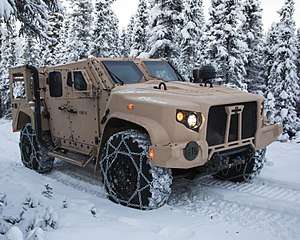 A production standard USMC JLTV in M1280 General Purpose (GP) configuration, this example fitted with a deep fording kit and tire chains.
A production standard USMC JLTV in M1280 General Purpose (GP) configuration, this example fitted with a deep fording kit and tire chains.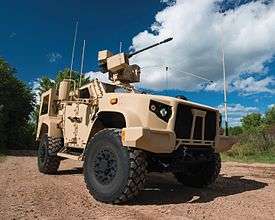 Oshkosh L-ATV in M1278 Heavy Guns Carrier JLTV configuration and fitted with an EOS R-400S-MK2 remote weapon system integrated with Orbital ATK's M230 LF 30 mm lightweight automatic chain gun
Oshkosh L-ATV in M1278 Heavy Guns Carrier JLTV configuration and fitted with an EOS R-400S-MK2 remote weapon system integrated with Orbital ATK's M230 LF 30 mm lightweight automatic chain gun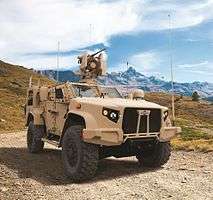 Oshkosh L-ATV in M1278 Heavy Guns Carrier JLTV configuration and equipped with M153 CROWS II remote weapon system integrated with M2 Browning .50 Caliber heavy machine gun
Oshkosh L-ATV in M1278 Heavy Guns Carrier JLTV configuration and equipped with M153 CROWS II remote weapon system integrated with M2 Browning .50 Caliber heavy machine gun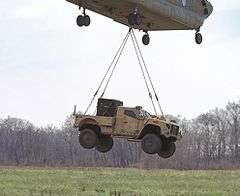 Oshkosh L-ATV in M1279 JLTV Utility configuration undergoing air-transport trials
Oshkosh L-ATV in M1279 JLTV Utility configuration undergoing air-transport trials Oshkosh L-ATV in M1278 Heavy Guns Carrier JLTV configuration with Objective Gunner Protection Kit (OGPK)
Oshkosh L-ATV in M1278 Heavy Guns Carrier JLTV configuration with Objective Gunner Protection Kit (OGPK) Rear three-quarter view of an Oshkosh L-ATV in M1278 Heavy Guns Carrier JLTV configuration
Rear three-quarter view of an Oshkosh L-ATV in M1278 Heavy Guns Carrier JLTV configuration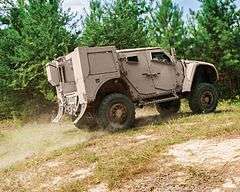 Oshkosh L-ATV in M1280 General Purpose JLTV configuration during trials
Oshkosh L-ATV in M1280 General Purpose JLTV configuration during trials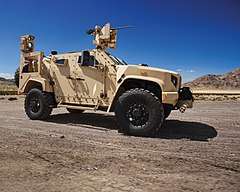 JLTV General Purpose variant fitted with a Boeing CLWS and a heavy machine gun-armed RWS
JLTV General Purpose variant fitted with a Boeing CLWS and a heavy machine gun-armed RWS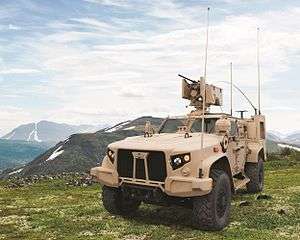 Oshkosh L-ATV configured as M1278 Heavy Guns Carrier.
Oshkosh L-ATV configured as M1278 Heavy Guns Carrier.
See also
References
- ↑ Humvee Replacement Delayed for Army and Marine Corps - Defensenews.com, 14 April 2016
- 1 2 3 4 5 Oshkosh Defense Wins JLTV Contract – Defensemedianetwork.com, 26 August 2015
- 1 2 Oshkosh Wins $6.7 Billion JLTV Contract – DoDBuzz.com, 25 August 2015
- 1 2 3 4 Oshkosh Wins JLTV Award – Armytimes.com, 25 August 2015
- ↑ "USMC Commandant Neller: Marines Made Cuts In FY2017 JLTV Buy To Save ACV, G/ATOR". USNI News (Megan Eckstein). Retrieved 2016-03-08.
- 1 2 ""Humvee" Replacement Powered by Banks-Built Duramax Diesel". trucktrend.com. August 2015. Retrieved 11 July 2017.
- ↑ "End of an icon: the rise and fall of the Humvee".
- 1 2 3 4 "Light Combat Tactical All-Terrain Vehicle (L-ATV), United States of America".
- ↑ US Army Orders First Lot of JLTVs From Oshkosh - Defensenews.com, 23 March 2016
- ↑ Daniel Wasserbly. "AUSA 2016: First JLTVs accepted, new testing round to begin". IHS Jane's. Retrieved October 7, 2016.
- ↑ "Retasking MRAP: Life after Afghanistan". Jane's IDR. Retrieved March 30, 2017.
- ↑ "Oshkosh Beats Lockheed, AM General For Historic JLTV Win". Breaking Defense. Retrieved August 26, 2015.
- ↑ Oshkosh wins contract to manufacture joint light tactical vehicle - Army.mil, 26 August 2015
- ↑ Oshkosh Wins $30 Billion Army Contract Battle to Replace Humvee - Defenseone.com, 25 August 2015
- ↑ Oshkosh grabs huge armored vehicle contract - Defensesystems.com, 27 August 2015
- ↑ Shaun Connors. "Oshkosh displays latest JLTV". Jane's Independent Defense Review. Retrieved March 12, 2015.
- ↑ Daniel Wasserbly. "DSEi: Oshkosh promotes L-ATV for US light vehicle contest". Jane's Defence Weekly. Retrieved March 12, 2015.
- ↑ A--AWARD NOTICE (MULTIPLE) for RFP W56HZV-11-R-0329 – Joint Light Tactical Vehicle (JLTV) Engineering and Manufacturing Development (EMD) phaseDoreen Costa (PoC). "A--AWARD NOTICE (MULTIPLE) for RFP W56HZV-11-R-0329 – Joint Light Tactical Vehicle (JLTV) Engineering and Manufacturing Development (EMD) phase". FedBizOpps.Gov. Retrieved March 29, 2015.
- ↑ "Army and Marine Corps pick JLTV winners" – DoDBuzz.com, August 23, 2012
- ↑ Oshkosh Defense. "Oshkosh displays latest JLTV". Oshkosh. Retrieved March 29, 2015.
- ↑ "Oshkosh Defense demonstrates its L-ATV prototypes for the U.S. Army JLTV program" – Armyrecognition.com, 14 June 2013
- ↑ PEO CS&CSS. "JLTV". PEO CS&CSS. Retrieved March 29, 2015.
- ↑ "Oshkosh Defense delivers the first Joint Light Tactical Vehicle to United States Army" – Armyrecognition.com, 8 August 2013
- ↑ Yasmin Tadjdeh. "Sequestration Threatens Joint Light Tactical Vehicle Acquisition". National Defense Magazine. Retrieved March 19, 2015.
- ↑ Dean Lockwood. "Forecast International Sees JLTV Program as a Bright Spot in a Down Market". Forecast International. Retrieved March 19, 2015.
- ↑ Andrew Feickert. "Joint Light Tactical Vehicle (JLTV): Background and Issues for Congress" (PDF). Congressional Research Service. Retrieved March 19, 2015.
- ↑ "Army, Marine Corps take delivery of JLTVs for user testing" – Army.mil, 27 August 2013
- ↑ "JLTV testing begins, program on schedule, budget" – Army.mil, 5 September 2013
- ↑ "Oshkosh Defense's JLTV Solution Completes 'Net-Ready' Testing" – Finance.Yahoo.com, 9 July 2014
- ↑ "Oshkosh Defense L-ATV Successfully Completes 200,000 Miles for JLTV EMD RAM Testing" – Marketwatch.com, 17 July 2014
- ↑ "Oshkosh Defense Light Combat Tactical All-Terrain Vehicle achieves key milestone in JLTV program" – Armyrecognition.com, 20 November 2014
- ↑ Army releases "RFP for Joint Light Tactical Vehicle" - Armytimes.com, 12 December 2014.
- ↑ "Oshkosh Defense Delivers Proposal for JLTV Production". Oshkosh Defense. Retrieved Feb 10, 2015.
- ↑ "Oshkosh Defense Showcases JLTV Solution, Virtual Task Trainer at AUSA Global Force Symposium". ftnews.firetrench.com. Retrieved Mar 31, 2015.
- ↑ "Lockheed Martin Protests JLTV contract award to Oshkosh". 8 September 2015. Retrieved 9 September 2015.
- ↑ Jen Judson (15 December 2015). "GAO Dismisses Lockheed JLTV Protest, Cites Pending Litigation". DefenseNews. Retrieved 16 December 2015.
- ↑ US Army Orders Oshkosh to Resumes JLTV Work - Defense-Update.com, 16 December 2015
- ↑ Lockheed Files Injunction To Stop Work On JLTV - Defensenews.com, 18 December 2015
- ↑ Lockheed Withdraws Protest of Army’s JLTV Award - DoDBuzz.com, 17 February 2016
- ↑ "Lockheed Drops JLTV Suit; DOT&E Knocks Reliability". breakingdefense.com (Sydney J Freedberg Jr.). 2016-02-18. Retrieved 2016-03-08.
- ↑ "DOT&E FY2015 Annual Report". DOT&E. Retrieved 2016-03-08.
- ↑ News Desk. "JLTV". defense-update.com. Retrieved April 7, 2017.
- ↑ Todd South. "These soldiers and Marines will be the first to get the military's newest combat vehicle". MilitaryTimes. Retrieved June 21, 2017.
- ↑ "Joint Light Tactical Vehicle (JLTV))". IHS Jane's Shaun C Connors, Christopher F Foss, Daniel Wasserbly. Retrieved 2017-08-07.
- ↑ Air Force’s surprise JLTV buy in FY18 could be start of larger procurement effort - Defensenews.com, 4 August 2017
- ↑ "Joint Light Tactical Vehicle (JLTV))". IHS Jane's Shaun C Connors, Christopher F Foss, Daniel Wasserbly. Retrieved 2017-09-09.
- ↑ Oshkosh Defense. "U.S. ARMY PLACES $195 MILLION ORDER FOR JOINT LIGHT TACTICAL VEHICLES". oshkoshdefense.com. Retrieved August 1, 2017.
- ↑ "Oshkosh makes Joint Light Tactical Vehicle more lethal". Defense News. Retrieved 2017-10-18.
- ↑ https://www.youtube.com/watch?v=HWmz45KRjI0
- ↑ "Joint Light Tactical Vehicle (JLTV) December 2017 order". Oshkosh Defense. Retrieved 2017-12-27.
- ↑ "Joint Light Tactical Vehicle (JLTV) February 2018 order". Oshkosh Defense. Retrieved 2018-02-07.
- ↑ "Joint Light Tactical Vehicle (JLTV) June 2018 order". Oshkosh Defense. Retrieved 2018-07-10.
- ↑ UK in Talks with Pentagon for JLTV Buy - Defensenews.com, 16 June 2016
- ↑ UK Plans to Buy $1 Billion Worth of JLTVs - DoDBuzz.com, 10 July 2017
- ↑ "Lithuania approaches the Pentagon over buying Oshkosh tactical vehicles". DefenseNews. Retrieved November 9, 2017.
- ↑ "Smooth ride: tracing the path to improved mobility" – Jane's International Defense Review (IDR), 18 August 2014
- ↑ "Oshkosh receives contract for MRAP suspension units" – Jane's Defense Industry, 29 September 2009
- 1 2 L-ATV Light Combat Tactical All-Terrain Vehicle Archived 2013-03-15 at the Wayback Machine. – Armyrecognition.com
- ↑ "Oshkosh's $30B Humvee replacement makes soldier protection a top priority". SAE International. 24 September 2015. Retrieved 3 February 2016.
- ↑ Oshkosh Defense. "ProPulse Product Sheet". Oshkosh Defense. Retrieved Feb 9, 2015.
- ↑ DoD Weapons Tester Report Sheds Light on JLTV Competition - Militarytimes.com, 2 February 2016
- ↑ Andrew Feickert. "JLTV Background & Issues For Congress". Congressional Research Service. Retrieved Feb 9, 2015.
- ↑ Kris Osborn. "Army crafts tailorable tactical wheeled vehicle acquisition strategy". www.army.mil. Retrieved Feb 9, 2015.
- ↑ AUSA 2015: Combat Vehicles Integrate Advanced Automotive, Protection Technologies - Defense-Update.com, 12 October 2015
- ↑ "MaxxPro Plus / MaxxPro Plus Ambulance". www.globalsecurity.org. Retrieved Feb 9, 2015.
- ↑ "RG-31 Nyala Mine Protected Vehicle". Defense Update. Retrieved Feb 9, 2015.
- ↑ "This Scaled-Down Armored Truck Could Be the Next Humvee" – Wired.com, 27 October 2014
- ↑ Shaun Connors. "Joint Light Tactical Vehicle (JLTV) 19/03/2017". IHS Jane's Joint Light Tactical Vehicle (JLTV) March 2017. Retrieved March 19, 2017.
- ↑ Daniel Wasserbly. "Pentagon budget 2018". Jane's Defence Weekly. Retrieved June 20, 2017.
External links
| Wikimedia Commons has media related to Oshkosh L-ATV. |
| Wikimedia Commons has media related to Oshkosh Corporation. |
- AUSA 2015: Oshkosh Defense on their L-ATV for JLTV (October 2015 video)
- Oshkosh L-ATV website
- "JLTV Ready (22 July 2015); YouTube".
- "Oshkosh Defense – Joint Light Tactical Vehicle (JLTV) (6 March 2015); YouTube".
- "Oshkosh L ATV Overview (5 min 23 sec overview by John Urias, President, Oshkosh Defense); YouTube".
- "Oshkosh Defense – Joint Light Tactical Vehicle (JLTV) [720p]; YouTube".
- "Oshkosh JLTV L-ATV variant promotional video; YouTube".
- "Oshkosh JLTV L-ATV demonstration at Quantico, Virginia; YouTube".
- "Oshkosh JLTV L-ATV interview with Senior Vice President at AUSA 2013 ; YouTube".
- "Oshkosh Light Concept Vehicle (L-ATV development) in 43rd Tecate SCORE Baja 1000 ; YouTube".
- "Oshkosh Light Combat Tactical All-Terrain Vehicle (L-ATV) international debut at IDEX 2013; YouTube".